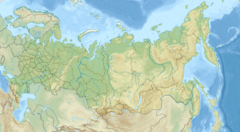.mw-parser-output .hidden-begin{box-sizing:border-box;width:100%;padding:5px;border:none;font-size:95%}.mw-parser-output .hidden-title{font-weight:bold;line-height:1.6;text-align:left}.mw-parser-output .hidden-content{text-align:left}@media all and (max-width:500px){.mw-parser-output .hidden-begin{width:auto!important;clear:none!important;float:none!important))You can help expand this article with text translated from the corresponding article in Russian. (January 2017) Click [show] for important translation instructions.
Machine translation, like DeepL or Google Translate, is a useful starting point for translations, but translators must revise errors as necessary and confirm that the translation is accurate, rather than simply copy-pasting machine-translated text into the English Wikipedia.
Consider adding a topic to this template: there are already 1,202 articles in the main category, and specifying|topic= will aid in categorization.
Do not translate text that appears unreliable or low-quality. If possible, verify the text with references provided in the foreign-language article.
You must provide copyright attribution in the edit summary accompanying your translation by providing an interlanguage link to the source of your translation. A model attribution edit summary is Content in this edit is translated from the existing Russian Wikipedia article at [[:ru:Восточный центр дальней космической связи]]; see its history for attribution.
You should also add the template ((Translated|ru|Восточный центр дальней космической связи)) to the talk page.
For more guidance, see Wikipedia:Translation.
You can help expand this article with text translated from the corresponding article in Ukrainian. (May 2023) Click [show] for important translation instructions.
Machine translation, like DeepL or Google Translate, is a useful starting point for translations, but translators must revise errors as necessary and confirm that the translation is accurate, rather than simply copy-pasting machine-translated text into the English Wikipedia.
Consider adding a topic to this template: there are already 319 articles in the main category, and specifying|topic= will aid in categorization.
Do not translate text that appears unreliable or low-quality. If possible, verify the text with references provided in the foreign-language article.
You must provide copyright attribution in the edit summary accompanying your translation by providing an interlanguage link to the source of your translation. A model attribution edit summary is Content in this edit is translated from the existing Ukrainian Wikipedia article at [[:uk:Східний центр далекого космічного зв'язку]]; see its history for attribution.
You should also add the template ((Translated|uk|Східний центр далекого космічного зв'язку)) to the talk page.
For more guidance, see Wikipedia:Translation.
 | |
| Location(s) | Galyonki, Pokrovsky rural settlement, Oktyabrsky District, Primorsky Krai, Primorsky Krai, Russia |
|---|---|
| Coordinates | 44°00′58″N 131°45′25″E / 44.0161°N 131.757°E |
| Altitude | 200 m (660 ft) |
| Telescope style | RT-70 radio telescope |
| Diameter | 70 m (229 ft 8 in) |
| | |
The Galenki RT-70 radio telescope (Russian: Галёнки РТ-70) is an RT-70 telescope at the East Center for Deep Space Communications, Galenki (Ussuriysk), Russia.
With its 70m antenna diameter, it is among the largest single dish radio telescopes in the world. It forms part of the Soviet Deep Space Network.
Two other RT-70 telescopes are:
- Yevpatoria RT-70 radio telescope – at the Center for Deep Space Communications, Yevpatoria
- Suffa RT-70 radio telescope – at the Suffa Radio Observatory
